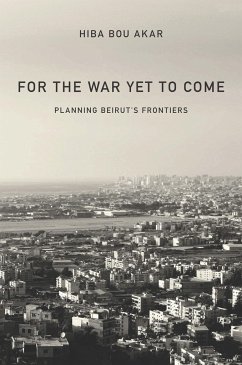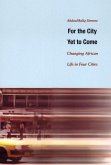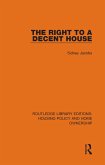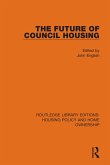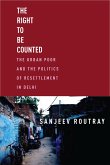- Gebundenes Buch
- Merkliste
- Auf die Merkliste
- Bewerten Bewerten
- Teilen
- Produkt teilen
- Produkterinnerung
- Produkterinnerung
Beirut is a city divided. Following the Green Line of the civil war, dividing the Christian east and the Muslim west, today hundreds of such lines dissect the city. For the residents of Beirut, urban planning could hold promise: a new spatial order could bring a peaceful future. But with unclear state structures and outsourced public processes, urban planning has instead become a contest between religious-political organizations and profit-seeking developers. Neighborhoods reproduce poverty, displacement, and urban violence. For the War Yet to Come examines urban planning in three…mehr
Andere Kunden interessierten sich auch für
![For the City Yet to Come For the City Yet to Come]() Abdoumaliq SimoneFor the City Yet to Come116,99 €
Abdoumaliq SimoneFor the City Yet to Come116,99 €![The Right to a Decent House The Right to a Decent House]() Sidney JacobsThe Right to a Decent House154,99 €
Sidney JacobsThe Right to a Decent House154,99 €![Is it Safe to Come Out Yet? Analysis: Japan's Policy for Hikikomori Is it Safe to Come Out Yet? Analysis: Japan's Policy for Hikikomori]() Bruce RosenthalIs it Safe to Come Out Yet? Analysis: Japan's Policy for Hikikomori80,99 €
Bruce RosenthalIs it Safe to Come Out Yet? Analysis: Japan's Policy for Hikikomori80,99 €![The Future of Council Housing The Future of Council Housing]() The Future of Council Housing154,99 €
The Future of Council Housing154,99 €![The Radical Homeowner The Radical Homeowner]() Ian C WinterThe Radical Homeowner139,99 €
Ian C WinterThe Radical Homeowner139,99 €![The Right to Be Counted The Right to Be Counted]() Sanjeev RoutrayThe Right to Be Counted104,99 €
Sanjeev RoutrayThe Right to Be Counted104,99 €![Locating Right to the City in the Global South Locating Right to the City in the Global South]() Locating Right to the City in the Global South203,99 €
Locating Right to the City in the Global South203,99 €-
-
-
Beirut is a city divided. Following the Green Line of the civil war, dividing the Christian east and the Muslim west, today hundreds of such lines dissect the city. For the residents of Beirut, urban planning could hold promise: a new spatial order could bring a peaceful future. But with unclear state structures and outsourced public processes, urban planning has instead become a contest between religious-political organizations and profit-seeking developers. Neighborhoods reproduce poverty, displacement, and urban violence. For the War Yet to Come examines urban planning in three neighborhoods of Beirut's southeastern peripheries, revealing how these areas have been developed into frontiers of a continuing sectarian order. Hiba Bou Akar argues these neighborhoods are arranged, not in the expectation of a bright future, but according to the logic of "the war yet to come": urban planning plays on fears and differences, rumors of war, and paramilitary strategies to organize everyday life. As she shows, war in times of peace is not fought with tanks, artillery, and rifles, but involves a more mundane territorial contest for land and apartment sales, zoning and planning regulations, and infrastructure projects.
Produktdetails
- Produktdetails
- Verlag: Stanford University Press
- Seitenzahl: 264
- Erscheinungstermin: 4. September 2018
- Englisch
- Abmessung: 257mm x 183mm x 23mm
- Gewicht: 726g
- ISBN-13: 9781503601918
- ISBN-10: 1503601919
- Artikelnr.: 47770732
- Verlag: Stanford University Press
- Seitenzahl: 264
- Erscheinungstermin: 4. September 2018
- Englisch
- Abmessung: 257mm x 183mm x 23mm
- Gewicht: 726g
- ISBN-13: 9781503601918
- ISBN-10: 1503601919
- Artikelnr.: 47770732
Hiba Bou Akar is Assistant Professor in the Graduate School of Architecture, Planning and Preservation at Columbia University. She has also worked as an architect and urban planner in Beirut.
Contents and Abstracts
Prologue: War in Times of Peace
chapter abstract
The Prologue offers a theorization of the spatial and temporal logics of
the war yet to come through which Beirut's south and southeastern
peripheries are governed and regulated. It locates these peripheries
spatially in the city, and provides an overview of how these peripheries,
in times of peace, have been transformed into frontiers of urban growth and
sectarian violence largely through the spatial practices of
religious-political organizations, mostly former civil war militias and the
major political players in post-civil war Lebanon. These organizations
include the Shiite Hezbollah, the Sunni Future Movement, the Druze
Progressive Socialist Party (PSP), and the Christian Maronite Church.
Chapter 1: Constructing Sectarian Geographies
chapter abstract
This chapter introduces the discourses through which sectarian geographies
are constructed in Beirut's peripheries. It discusses how commonly used
terms like environment (b¿a in Arabic) and demography can be used to
depoliticize spatial policies and practices of segregation, discrimination,
and fear by relegating them from realm of the political to the realm of the
natural and scientific. Through an overview of the study's approach, which
included patching stories and maps together with real-time data collection,
this chapter engages with the methodological question of conducting
research in contested spaces and violent geographies. This chapter also
situates the book within the interdisciplinary fields of urban and planning
studies, Middle Eastern studies, and studies on conflict urbanism and
militarization. It also explains the three research sites, and theorizes
the ways in which they, together, contribute to an understanding of the
geographies and temporalities of the war yet to come in contested spaces.
Chapter 2: The Doubleness of Ruins
chapter abstract
This chapter examines the still visible, expansive geography of war-scarred
ruins left by the civil war in Hayy Madi/Mar Mikhail, by examining the
transformation of these geographies of ruins within the unfolding
sectarian-political spatial conflict. The doubleness of ruins arises from
their being products of both a past civil war and a present territorial war
that is not so different from the civil war but that uses different tools.
Through this exploration, the chapter shows how the Hayy Madi/Mar Mikhail
neighborhoods have become one of the major contested frontiers, one where
the Christians (through the Maronite Church) and the Shiites (through
Hezbollah-affiliated real estate developers) are struggling over land
locally and through global networks of finance, fundraising, and religious
allegiances, and where this struggle is transforming Hayy Madi/Mar Mikhail
into a sectarian frontier in times of peace.
Chapter 3: The Lacework of Zoning
chapter abstract
This chapter traces how urban planning and zoning technologies have become
technologies of warfare in times of peace, transforming Sahra Choueifat, a
southeastern periphery of Beirut, into a deadly frontier of contestation
and violence. The territorial battle of Hezbollah and the PSP over the area
through zoning policies and real estate and housing markets is resulting in
what this chapter calls the lacework of zoning. This low-income periphery
is now a patchwork of apartment buildings that are in the vicinity of
industries that are next to one of the most active urban agricultural areas
around Beirut, with severe repercussions on the everyday life of area
residents. The chapter describes how areas known to be Hezbollah's spaces
in Beirut are in fact produced by the continuities and discontinuities of
neoliberal practices with practices of religious affiliation, sectarian
constructions, service provision, resistance ideologies, and
militarization.
Chapter 4: A Ballooning Frontier
chapter abstract
This chapter shows how access to development sites and individual project
characteristics are resulting in the simultaneous (and competitive)
ballooning of Shiite al-Dahiya and the city core (primarily Sunni west
Beirut) toward Doha Aramoun, a periphery that emerged as a violent frontier
in the May 2008 sectarian violence. Ballooning takes place on a variety of
scales, from constructing more floors than initially permitted in a
building to working behind the scenes with government agencies or
religious-political organizations to bypass market mechanisms to using
international aid to build infrastructure that enables the extension of
sectarian patterns of urbanization. Thus, in Doha Aramoun, large-scale,
nationally sanctioned building and planning projects have combined with the
building-by-building efforts of Hezbollah-affiliated developers to
transform a formerly marginal periphery into a prime new site for sectarian
violence. In these territorial battles, minority religious groups become
brokers between dominant religious groups.
Chapter 5: Planning without Development
chapter abstract
This chapter describes the genealogy of the sectarian order in Lebanon and
how it came to be understood and practiced spatially. This genealogy is
constructed by tracing the debates and discourses that circulated among
experts in the fields of development and urban planning since the 1950s,
soon after the establishment of the Lebanese post-colonial nation state.
The chapter shows how, over time, urban planning was voided of its
development discourses, and transformed through militias' and
religious-political organizations' interventions into a collection of
"innovative" exercises aimed at balancing the spatiality of a sectarian
order. It illustrates how these shifts in logic coincided with global
moments of anxiety around Communism, and later, political Islam, ultimately
ushering in the spatial and temporal logics of the wars yet to come. It
closes with a discussion on how planning experts have become the
technicians of this logic.
Epilogue: Contested Futures
chapter abstract
This closing discussion of contested futures shows how the geographies and
temporalities of the war yet to come are often dystopic, foreclosing the
possibilities of urban politics and social change outside the
sociopolitical order of political difference. At the same time, it shows
that hope for change lies in the continuously shifting and contested
spatialities of the sectarian order. It also explains this study's
relevance beyond Beirut, discussing the implications of the findings for
urban studies research in cities across the Global South and Global North.
By contending that the urban futures of all cities are being contested,
this chapter argues that while the logic of anticipated wars is particular
to cities like Beirut, many other cities are governed, regulated, and
contested by the logics of conflicts that are yet to come, driven by
terror, gun violence, and climate change.
Prologue: War in Times of Peace
chapter abstract
The Prologue offers a theorization of the spatial and temporal logics of
the war yet to come through which Beirut's south and southeastern
peripheries are governed and regulated. It locates these peripheries
spatially in the city, and provides an overview of how these peripheries,
in times of peace, have been transformed into frontiers of urban growth and
sectarian violence largely through the spatial practices of
religious-political organizations, mostly former civil war militias and the
major political players in post-civil war Lebanon. These organizations
include the Shiite Hezbollah, the Sunni Future Movement, the Druze
Progressive Socialist Party (PSP), and the Christian Maronite Church.
Chapter 1: Constructing Sectarian Geographies
chapter abstract
This chapter introduces the discourses through which sectarian geographies
are constructed in Beirut's peripheries. It discusses how commonly used
terms like environment (b¿a in Arabic) and demography can be used to
depoliticize spatial policies and practices of segregation, discrimination,
and fear by relegating them from realm of the political to the realm of the
natural and scientific. Through an overview of the study's approach, which
included patching stories and maps together with real-time data collection,
this chapter engages with the methodological question of conducting
research in contested spaces and violent geographies. This chapter also
situates the book within the interdisciplinary fields of urban and planning
studies, Middle Eastern studies, and studies on conflict urbanism and
militarization. It also explains the three research sites, and theorizes
the ways in which they, together, contribute to an understanding of the
geographies and temporalities of the war yet to come in contested spaces.
Chapter 2: The Doubleness of Ruins
chapter abstract
This chapter examines the still visible, expansive geography of war-scarred
ruins left by the civil war in Hayy Madi/Mar Mikhail, by examining the
transformation of these geographies of ruins within the unfolding
sectarian-political spatial conflict. The doubleness of ruins arises from
their being products of both a past civil war and a present territorial war
that is not so different from the civil war but that uses different tools.
Through this exploration, the chapter shows how the Hayy Madi/Mar Mikhail
neighborhoods have become one of the major contested frontiers, one where
the Christians (through the Maronite Church) and the Shiites (through
Hezbollah-affiliated real estate developers) are struggling over land
locally and through global networks of finance, fundraising, and religious
allegiances, and where this struggle is transforming Hayy Madi/Mar Mikhail
into a sectarian frontier in times of peace.
Chapter 3: The Lacework of Zoning
chapter abstract
This chapter traces how urban planning and zoning technologies have become
technologies of warfare in times of peace, transforming Sahra Choueifat, a
southeastern periphery of Beirut, into a deadly frontier of contestation
and violence. The territorial battle of Hezbollah and the PSP over the area
through zoning policies and real estate and housing markets is resulting in
what this chapter calls the lacework of zoning. This low-income periphery
is now a patchwork of apartment buildings that are in the vicinity of
industries that are next to one of the most active urban agricultural areas
around Beirut, with severe repercussions on the everyday life of area
residents. The chapter describes how areas known to be Hezbollah's spaces
in Beirut are in fact produced by the continuities and discontinuities of
neoliberal practices with practices of religious affiliation, sectarian
constructions, service provision, resistance ideologies, and
militarization.
Chapter 4: A Ballooning Frontier
chapter abstract
This chapter shows how access to development sites and individual project
characteristics are resulting in the simultaneous (and competitive)
ballooning of Shiite al-Dahiya and the city core (primarily Sunni west
Beirut) toward Doha Aramoun, a periphery that emerged as a violent frontier
in the May 2008 sectarian violence. Ballooning takes place on a variety of
scales, from constructing more floors than initially permitted in a
building to working behind the scenes with government agencies or
religious-political organizations to bypass market mechanisms to using
international aid to build infrastructure that enables the extension of
sectarian patterns of urbanization. Thus, in Doha Aramoun, large-scale,
nationally sanctioned building and planning projects have combined with the
building-by-building efforts of Hezbollah-affiliated developers to
transform a formerly marginal periphery into a prime new site for sectarian
violence. In these territorial battles, minority religious groups become
brokers between dominant religious groups.
Chapter 5: Planning without Development
chapter abstract
This chapter describes the genealogy of the sectarian order in Lebanon and
how it came to be understood and practiced spatially. This genealogy is
constructed by tracing the debates and discourses that circulated among
experts in the fields of development and urban planning since the 1950s,
soon after the establishment of the Lebanese post-colonial nation state.
The chapter shows how, over time, urban planning was voided of its
development discourses, and transformed through militias' and
religious-political organizations' interventions into a collection of
"innovative" exercises aimed at balancing the spatiality of a sectarian
order. It illustrates how these shifts in logic coincided with global
moments of anxiety around Communism, and later, political Islam, ultimately
ushering in the spatial and temporal logics of the wars yet to come. It
closes with a discussion on how planning experts have become the
technicians of this logic.
Epilogue: Contested Futures
chapter abstract
This closing discussion of contested futures shows how the geographies and
temporalities of the war yet to come are often dystopic, foreclosing the
possibilities of urban politics and social change outside the
sociopolitical order of political difference. At the same time, it shows
that hope for change lies in the continuously shifting and contested
spatialities of the sectarian order. It also explains this study's
relevance beyond Beirut, discussing the implications of the findings for
urban studies research in cities across the Global South and Global North.
By contending that the urban futures of all cities are being contested,
this chapter argues that while the logic of anticipated wars is particular
to cities like Beirut, many other cities are governed, regulated, and
contested by the logics of conflicts that are yet to come, driven by
terror, gun violence, and climate change.
Contents and Abstracts
Prologue: War in Times of Peace
chapter abstract
The Prologue offers a theorization of the spatial and temporal logics of
the war yet to come through which Beirut's south and southeastern
peripheries are governed and regulated. It locates these peripheries
spatially in the city, and provides an overview of how these peripheries,
in times of peace, have been transformed into frontiers of urban growth and
sectarian violence largely through the spatial practices of
religious-political organizations, mostly former civil war militias and the
major political players in post-civil war Lebanon. These organizations
include the Shiite Hezbollah, the Sunni Future Movement, the Druze
Progressive Socialist Party (PSP), and the Christian Maronite Church.
Chapter 1: Constructing Sectarian Geographies
chapter abstract
This chapter introduces the discourses through which sectarian geographies
are constructed in Beirut's peripheries. It discusses how commonly used
terms like environment (b¿a in Arabic) and demography can be used to
depoliticize spatial policies and practices of segregation, discrimination,
and fear by relegating them from realm of the political to the realm of the
natural and scientific. Through an overview of the study's approach, which
included patching stories and maps together with real-time data collection,
this chapter engages with the methodological question of conducting
research in contested spaces and violent geographies. This chapter also
situates the book within the interdisciplinary fields of urban and planning
studies, Middle Eastern studies, and studies on conflict urbanism and
militarization. It also explains the three research sites, and theorizes
the ways in which they, together, contribute to an understanding of the
geographies and temporalities of the war yet to come in contested spaces.
Chapter 2: The Doubleness of Ruins
chapter abstract
This chapter examines the still visible, expansive geography of war-scarred
ruins left by the civil war in Hayy Madi/Mar Mikhail, by examining the
transformation of these geographies of ruins within the unfolding
sectarian-political spatial conflict. The doubleness of ruins arises from
their being products of both a past civil war and a present territorial war
that is not so different from the civil war but that uses different tools.
Through this exploration, the chapter shows how the Hayy Madi/Mar Mikhail
neighborhoods have become one of the major contested frontiers, one where
the Christians (through the Maronite Church) and the Shiites (through
Hezbollah-affiliated real estate developers) are struggling over land
locally and through global networks of finance, fundraising, and religious
allegiances, and where this struggle is transforming Hayy Madi/Mar Mikhail
into a sectarian frontier in times of peace.
Chapter 3: The Lacework of Zoning
chapter abstract
This chapter traces how urban planning and zoning technologies have become
technologies of warfare in times of peace, transforming Sahra Choueifat, a
southeastern periphery of Beirut, into a deadly frontier of contestation
and violence. The territorial battle of Hezbollah and the PSP over the area
through zoning policies and real estate and housing markets is resulting in
what this chapter calls the lacework of zoning. This low-income periphery
is now a patchwork of apartment buildings that are in the vicinity of
industries that are next to one of the most active urban agricultural areas
around Beirut, with severe repercussions on the everyday life of area
residents. The chapter describes how areas known to be Hezbollah's spaces
in Beirut are in fact produced by the continuities and discontinuities of
neoliberal practices with practices of religious affiliation, sectarian
constructions, service provision, resistance ideologies, and
militarization.
Chapter 4: A Ballooning Frontier
chapter abstract
This chapter shows how access to development sites and individual project
characteristics are resulting in the simultaneous (and competitive)
ballooning of Shiite al-Dahiya and the city core (primarily Sunni west
Beirut) toward Doha Aramoun, a periphery that emerged as a violent frontier
in the May 2008 sectarian violence. Ballooning takes place on a variety of
scales, from constructing more floors than initially permitted in a
building to working behind the scenes with government agencies or
religious-political organizations to bypass market mechanisms to using
international aid to build infrastructure that enables the extension of
sectarian patterns of urbanization. Thus, in Doha Aramoun, large-scale,
nationally sanctioned building and planning projects have combined with the
building-by-building efforts of Hezbollah-affiliated developers to
transform a formerly marginal periphery into a prime new site for sectarian
violence. In these territorial battles, minority religious groups become
brokers between dominant religious groups.
Chapter 5: Planning without Development
chapter abstract
This chapter describes the genealogy of the sectarian order in Lebanon and
how it came to be understood and practiced spatially. This genealogy is
constructed by tracing the debates and discourses that circulated among
experts in the fields of development and urban planning since the 1950s,
soon after the establishment of the Lebanese post-colonial nation state.
The chapter shows how, over time, urban planning was voided of its
development discourses, and transformed through militias' and
religious-political organizations' interventions into a collection of
"innovative" exercises aimed at balancing the spatiality of a sectarian
order. It illustrates how these shifts in logic coincided with global
moments of anxiety around Communism, and later, political Islam, ultimately
ushering in the spatial and temporal logics of the wars yet to come. It
closes with a discussion on how planning experts have become the
technicians of this logic.
Epilogue: Contested Futures
chapter abstract
This closing discussion of contested futures shows how the geographies and
temporalities of the war yet to come are often dystopic, foreclosing the
possibilities of urban politics and social change outside the
sociopolitical order of political difference. At the same time, it shows
that hope for change lies in the continuously shifting and contested
spatialities of the sectarian order. It also explains this study's
relevance beyond Beirut, discussing the implications of the findings for
urban studies research in cities across the Global South and Global North.
By contending that the urban futures of all cities are being contested,
this chapter argues that while the logic of anticipated wars is particular
to cities like Beirut, many other cities are governed, regulated, and
contested by the logics of conflicts that are yet to come, driven by
terror, gun violence, and climate change.
Prologue: War in Times of Peace
chapter abstract
The Prologue offers a theorization of the spatial and temporal logics of
the war yet to come through which Beirut's south and southeastern
peripheries are governed and regulated. It locates these peripheries
spatially in the city, and provides an overview of how these peripheries,
in times of peace, have been transformed into frontiers of urban growth and
sectarian violence largely through the spatial practices of
religious-political organizations, mostly former civil war militias and the
major political players in post-civil war Lebanon. These organizations
include the Shiite Hezbollah, the Sunni Future Movement, the Druze
Progressive Socialist Party (PSP), and the Christian Maronite Church.
Chapter 1: Constructing Sectarian Geographies
chapter abstract
This chapter introduces the discourses through which sectarian geographies
are constructed in Beirut's peripheries. It discusses how commonly used
terms like environment (b¿a in Arabic) and demography can be used to
depoliticize spatial policies and practices of segregation, discrimination,
and fear by relegating them from realm of the political to the realm of the
natural and scientific. Through an overview of the study's approach, which
included patching stories and maps together with real-time data collection,
this chapter engages with the methodological question of conducting
research in contested spaces and violent geographies. This chapter also
situates the book within the interdisciplinary fields of urban and planning
studies, Middle Eastern studies, and studies on conflict urbanism and
militarization. It also explains the three research sites, and theorizes
the ways in which they, together, contribute to an understanding of the
geographies and temporalities of the war yet to come in contested spaces.
Chapter 2: The Doubleness of Ruins
chapter abstract
This chapter examines the still visible, expansive geography of war-scarred
ruins left by the civil war in Hayy Madi/Mar Mikhail, by examining the
transformation of these geographies of ruins within the unfolding
sectarian-political spatial conflict. The doubleness of ruins arises from
their being products of both a past civil war and a present territorial war
that is not so different from the civil war but that uses different tools.
Through this exploration, the chapter shows how the Hayy Madi/Mar Mikhail
neighborhoods have become one of the major contested frontiers, one where
the Christians (through the Maronite Church) and the Shiites (through
Hezbollah-affiliated real estate developers) are struggling over land
locally and through global networks of finance, fundraising, and religious
allegiances, and where this struggle is transforming Hayy Madi/Mar Mikhail
into a sectarian frontier in times of peace.
Chapter 3: The Lacework of Zoning
chapter abstract
This chapter traces how urban planning and zoning technologies have become
technologies of warfare in times of peace, transforming Sahra Choueifat, a
southeastern periphery of Beirut, into a deadly frontier of contestation
and violence. The territorial battle of Hezbollah and the PSP over the area
through zoning policies and real estate and housing markets is resulting in
what this chapter calls the lacework of zoning. This low-income periphery
is now a patchwork of apartment buildings that are in the vicinity of
industries that are next to one of the most active urban agricultural areas
around Beirut, with severe repercussions on the everyday life of area
residents. The chapter describes how areas known to be Hezbollah's spaces
in Beirut are in fact produced by the continuities and discontinuities of
neoliberal practices with practices of religious affiliation, sectarian
constructions, service provision, resistance ideologies, and
militarization.
Chapter 4: A Ballooning Frontier
chapter abstract
This chapter shows how access to development sites and individual project
characteristics are resulting in the simultaneous (and competitive)
ballooning of Shiite al-Dahiya and the city core (primarily Sunni west
Beirut) toward Doha Aramoun, a periphery that emerged as a violent frontier
in the May 2008 sectarian violence. Ballooning takes place on a variety of
scales, from constructing more floors than initially permitted in a
building to working behind the scenes with government agencies or
religious-political organizations to bypass market mechanisms to using
international aid to build infrastructure that enables the extension of
sectarian patterns of urbanization. Thus, in Doha Aramoun, large-scale,
nationally sanctioned building and planning projects have combined with the
building-by-building efforts of Hezbollah-affiliated developers to
transform a formerly marginal periphery into a prime new site for sectarian
violence. In these territorial battles, minority religious groups become
brokers between dominant religious groups.
Chapter 5: Planning without Development
chapter abstract
This chapter describes the genealogy of the sectarian order in Lebanon and
how it came to be understood and practiced spatially. This genealogy is
constructed by tracing the debates and discourses that circulated among
experts in the fields of development and urban planning since the 1950s,
soon after the establishment of the Lebanese post-colonial nation state.
The chapter shows how, over time, urban planning was voided of its
development discourses, and transformed through militias' and
religious-political organizations' interventions into a collection of
"innovative" exercises aimed at balancing the spatiality of a sectarian
order. It illustrates how these shifts in logic coincided with global
moments of anxiety around Communism, and later, political Islam, ultimately
ushering in the spatial and temporal logics of the wars yet to come. It
closes with a discussion on how planning experts have become the
technicians of this logic.
Epilogue: Contested Futures
chapter abstract
This closing discussion of contested futures shows how the geographies and
temporalities of the war yet to come are often dystopic, foreclosing the
possibilities of urban politics and social change outside the
sociopolitical order of political difference. At the same time, it shows
that hope for change lies in the continuously shifting and contested
spatialities of the sectarian order. It also explains this study's
relevance beyond Beirut, discussing the implications of the findings for
urban studies research in cities across the Global South and Global North.
By contending that the urban futures of all cities are being contested,
this chapter argues that while the logic of anticipated wars is particular
to cities like Beirut, many other cities are governed, regulated, and
contested by the logics of conflicts that are yet to come, driven by
terror, gun violence, and climate change.

